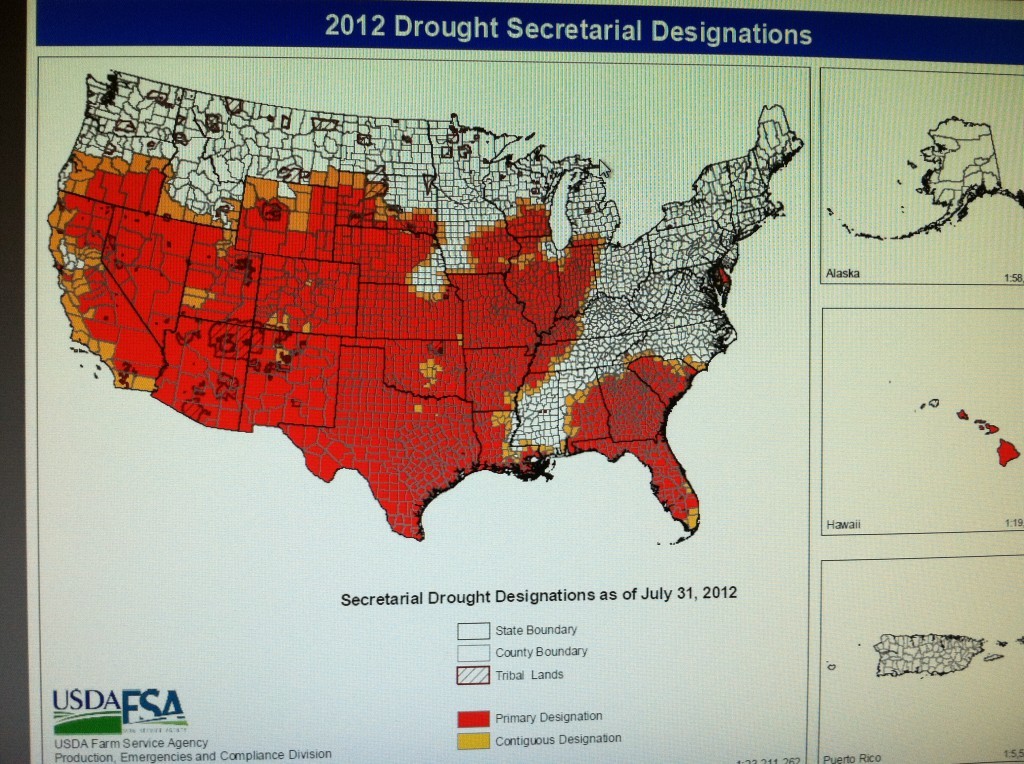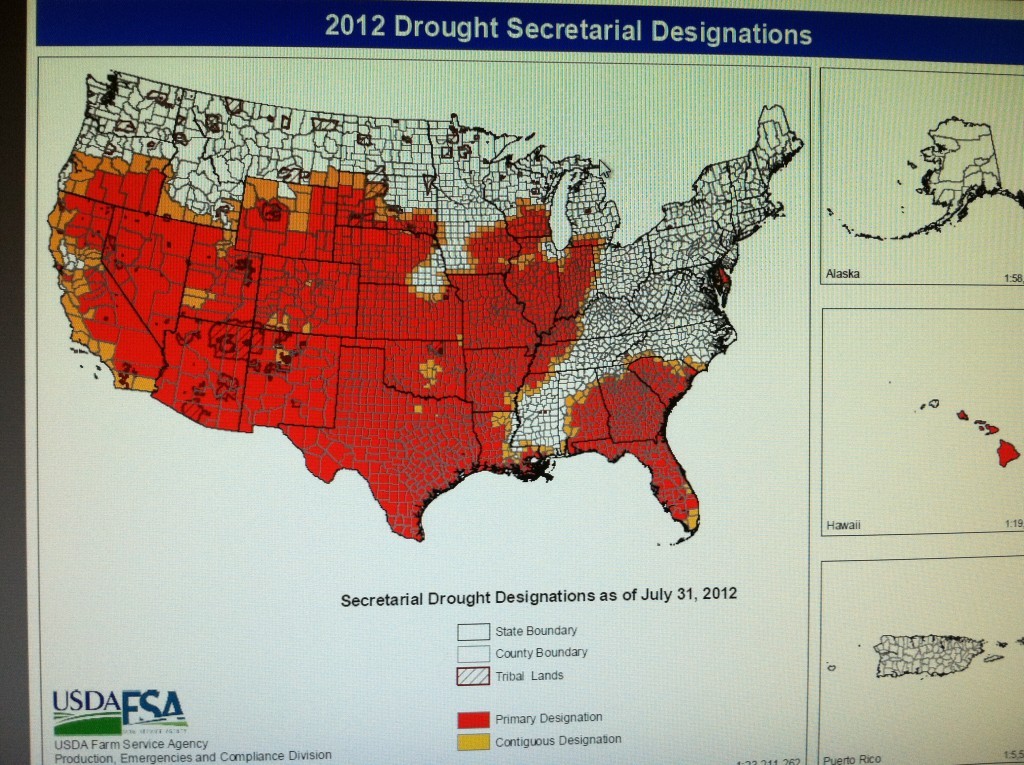Agriculture Secretary Tom Vilsack announced two new pieces of disaster assistance for farmers and ranchers impacted by the nation’s worsening drought.
First, Vilsack is expanding emergency haying and grazing on approximately 3.8 million acres of conservation land to bring greater relief to livestock producers dealing with shortages of hay and pastureland.
Second, the Secretary announced that crop insurance companies have agreed to provide a short grace period for farmers on insurance premiums in 2012. As a result, farming families now have an extra 30 days to make payments without incurring interest penalties on unpaid premiums.
Vilsack signed disaster designations for an additional 218 counties in 12 states as primary natural disaster areas due to damage and losses caused by drought and excessive heat. Counties designated are in the states of Arkansas, Georgia, Iowa, Illinois, Indiana, Kansas, Mississippi, Nebraska, Oklahoma, South Dakota, Tennessee and Wyoming. More than half (50.3 percent) of all counties in the United States have been designated disaster areas by USDA in 2012, mainly due to drought.

Emergency Haying and Grazing
In response to the expanding drought, Secretary Vilsack today announced that livestock producers and other participants in the Conservation Reserve Program (CRP) will now be able to hay and graze acres that have been ineligible in the past. Many of these additional acres have wetland-related characteristics and are likely to contain better quality hay and forage than on other CRP acres.
There are approximately 3.8 million acres that will now be eligible for emergency haying and grazing, subject to certain conditions. Haying and grazing may only occur under strict compliance rules to help minimize impacts on these sensitive specialty practices.
In addition, USDA will conduct follow-up monitoring and evaluation of these opened CRP areas to study the effects of the drought and USDA’s emergency haying and grazing actions.
Federal Crop Insurance
Secretary Vilsack announced that crop insurance companies have agreed to provide a short grace period for farmers on insurance premiums in 2012. To help producers who may have cash flow problems due to natural disasters, Secretary Vilsack sent a letter to crop insurance companies asking them to voluntarily defer the accrual of any interest on unpaid spring crop premiums by producers until November 1, 2012. In turn, to assist the crop insurance companies, USDA will not require crop insurance companies to pay uncollected producer premiums until one month later.
During the 2012 crop year, USDA has designated 1,584 unduplicated counties across 32 states as disaster areas—1,452 due to drought—making all qualified farm operators in the areas eligible for low-interest emergency loans.
U.S. Drought Monitor indicates that 66 percent of the nation’s hay acreage is in an area experiencing drought, while approximately 73 percent of the nation’s cattle acreage is in an area experiencing drought.
During the week ending July 29, USDA’s National Agricultural Statistics Service reported that U.S. soybeans rated 37 percent very poor to poor, matching the lowest conditions observed during the drought of 1988. NASS also reported that 48 percent of the U.S. corn crop was rated very poor to poor, while 57 percent of the nation’s pastures and rangeland are rated very poor or poor condition.
The USDA has announced a variety of steps to get assistance to producers impacted by the worsening drought, including:
- Allowing additional acres under CRP to be used for emergency haying or grazing. The action allows lands that are not yet classified as “under severe drought” but that are “abnormally dry” to be used for haying and grazing.
- Allowing producers to modify current Environmental Quality Incentives Program (EQIP) contracts to allow for grazing, livestock watering, and other conservation activities to address drought conditions.
- Authorizing haying and grazing of Wetlands Reserve Program (WRP) easement areas in drought-affected areas where haying and grazing is consistent with conservation of wildlife habitat and wetlands. USDA has expedited its authorization process for this haying and grazing.
- Encouraging crop insurance companies to provide a short grace period for farmers on unpaid insurance premiums, as some farming families can be expected to struggle to make ends meet at the close of the crop year.
- Reducing the emergency loan interest rate from 3.75 percent to 2.25 percent.
- Lowering the reduction in the annual rental payment to producers on CRP acres used for emergency haying or grazing from 25 percent to 10 percent in 2012.
- Simplifying the Secretarial disaster designation process and reduced the time it takes to designate counties affected by disasters by 40 percent.
The U.S. Small Business Administration has also made 63 agency declarations in 33 states covering 1,675 counties, providing a pathway for those affected to apply for an Economic Injury Disaster Loan (EIDL). SBA’s EIDLs are available to small, non-farm businesses and small agricultural cooperatives that are economically affected by the drought in their community.
The USDA’s crop insurance program currently insures 264 million acres, 1.14 million policies, and $110 billion worth of liability on about 500,000 farms.
Source: USDA
Was this article valuable?
Here are more articles you may enjoy.


 Nearly 1,000 Feared Dead After Cyclone Hits France’s Mayotte
Nearly 1,000 Feared Dead After Cyclone Hits France’s Mayotte  Uber Warns NYC Response to Insolvent Insurer Exposes Drivers
Uber Warns NYC Response to Insolvent Insurer Exposes Drivers  Senate Says Climate Is Driving Insurance Non-renewals; Industry Strikes Back
Senate Says Climate Is Driving Insurance Non-renewals; Industry Strikes Back  Mississippi High Court Tells USAA to Pay up in Hurricane Katrina Bad-Faith Claim
Mississippi High Court Tells USAA to Pay up in Hurricane Katrina Bad-Faith Claim 